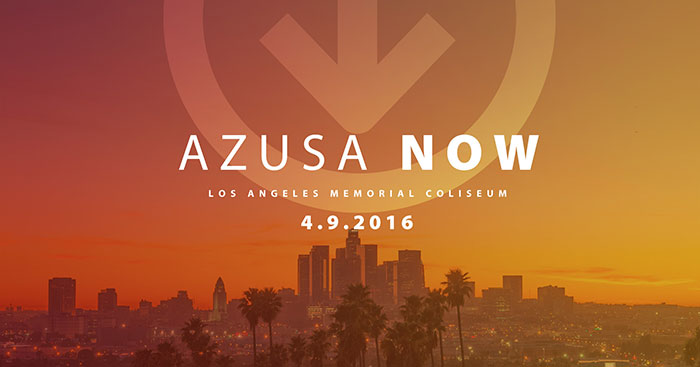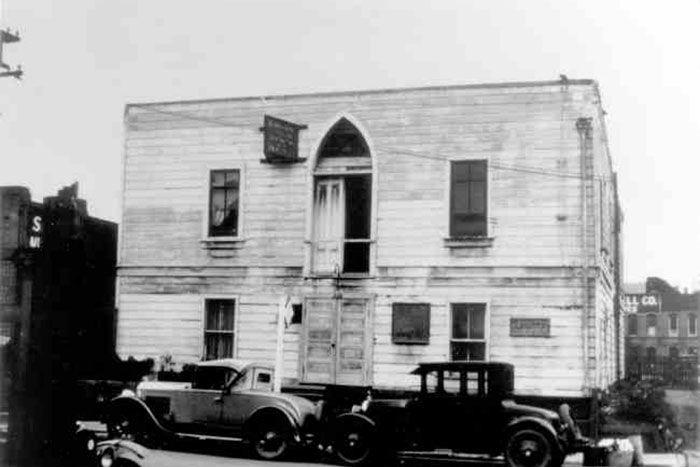This week marks the 110th anniversary of the Azusa Street Revival of 1906, with a 100,000-person gathering happening today in Los Angeles, called Azusa Now. City News looks at the then and now of this world-changing event.
The 1906 Azusa Street Revival was the most important event in the history of the modern day Pentecostal church. Over the 110 years, the effects of Azusa could be felt worldwide—the Holy Spirit manifested Himself across nations over the past 11 decades.
Later today in Los Angeles, starting at 7am (Pacific Time) and ending at 10.30pm, over 100,000 Christians will be gathering at the LA Coliseum to celebrate Azusa Now, an event organized by TheCall, a ministry by preacher Lou Engle.
According to TheCall’s website this is what will happen at the event: “Believing that decades of globe-spanning prayer have saturated the heavens, we will boldly ask God for the rain of revival on April 9th, 2016. We will consecrate an entire day — 15 hours — for the purpose of unity, miracles, healing, and the proclamation of the gospel. Our rally cry: Come, Holy Spirit! Instead of 120 in the Upper Room, we seek to gather as many as 120,000 in one place and one accord to simply exalt Jesus. And for inspiration, we turn to the most powerful expression of revival in modern times: the historic Azusa Street Revival of 1906.”
HOW DID THE AZUSA STREET REVIVAL COME ABOUT?
On April 14, 1906, an African-American preacher named William J (“WJ”) Seymour, held a church service in an old warehouse on Azusa Street in Los Angeles, California. That service was the beginning of a three-year revival at that location, which was characterized by the Pentecostal message of baptism in the Holy Spirit and the Pentecostal experience of speaking in tongues.
“The Azusa St. Revival” ignited a worldwide movement, the growth of which has seldom been seen in the history of Christianity.
Seymour’s small group met in a house-church on Bonnie Brae Street, the home of Richard and Ruth Asberry. On April 12, 1906, after praying all night, Seymour spoke in tongues for the first time. When word got out that unusual expressions of the Holy Spirit were occurring at the small house-church, crowds flocked to the residence. The group were eventually forced to relocate.
They found an available building, an old 4,800-square-foot warehouse, at 312 Azusa Street for US$8 a month. The group’s first meeting there was on April 14, 1906. By the following month, services as many as 1,500 people at a time, and these attendees were racially and economically diverse. People came from different denominations as well, from Baptists to Quakers, and Presbyterians. The gatherings at Azusa Street were unlike other church service—there was no choir, no taking of offering, just thousands baptized in the Holy Spirit, speaking and singing in tongues. There was also prayer happening on a brand new level and healings and miracles abounded.
Three key factors at Azusa mirrored the reality of the formation of the church in Acts 2. Firstly, there was a multi-ethnic gathering of unity in Christ (Acts 2:1-11). Secondly, the miraculous, attesting ministry of the Holy Spirit was enjoyed in a unique way (Acts 2:2-4). Finally, there was a clear presentation of the Gospel leading many to salvation (Acts 2:37-41).
This outpouring of Heaven fell upon on the poor districts of Los Angeles during a volatile and prejudiced period of American history. God used Seymour, an African American to launch this modern Acts 2 movement. Black, white, Asian and Hispanic came together in bonds of love, unity and prayer. It was said that the “color line was washed away” at Azusa.
Probably the most important legacy of the Azusa Street Revival was the renewal of the gifts of the Spirit (also called charismata) for the modern church. For centuries, Western churches, both Roman Catholic and Protestant, had adopted the view that the gifts of the Spirit had ceased at the end of the Apostolic Age. Known as the cessation theory, this view became especially dominant among fundamentalists that rejected Pentecostalism. With the explosion of tongues at Azusa Street, the attention of the Church was also drawn to the other gifts of the Spirit. In addition to praying in tongues, or glossolalia, the gifts of prophecy and healing came into prominence.
THE IMPACT ON SINGAPORE AND CITY HARVEST CHURCH
According to senior pastor of City Harvest Church, Kong Hee, “in 1960, the Pentecostal movement entered mainline Protestant churches when American Anglican vicar, Reverend Dennis Bennett, became Spirit-filled and started speaking in tongues. What followed became known as the ‘Charismatic Renewal of the 20th Century’.”
In Singapore, in 1972, the Holy Spirit was poured out upon some Singaporean students of Anglo-Chinese School and St. Andrew’s School in similarly dramatic fashion. They experienced the baptism in the Holy Spirit and spoke in tongues in September that same year. Many consider those events as the birth of the Charismatic movement in Singapore. To ensure that those zealous Christian youths were not led astray, Anglican clergy Reverend Canon James Wong, founder of the Chapel of the Ascension, was assigned to provide pastoral oversight over them.
Kong recalls: “During the last week of December 1972, Reverend Ralph Wilkerson, the senior pastor of Melodyland Christian Center in Anaheim, California, came to Singapore. Canon Wong became very open to the Holy Spirit and was himself filled with the Holy Spirit. Anglican Bishop Chiu Ban It and Canon Wong were like the apostles Peter and John in the Book of Acts, and brought the Charismatic Renewal to all of Singapore and South-east Asia from 1974 to 1975. Today, these two men are widely recognized as the pioneers of the ‘Charismatic Renewal’ in Singapore.
“It was during those exciting times when I myself received Jesus Christ as my Savior and Lord, and experienced Him as the Baptizer in the Holy Spirit. Although I was only 11 years old then, and had never been to a Charismatic service, I too spoke in other tongues when the Holy Spirit came upon me at the ‘upper room’ of my grandmother’s house.”
The word “revival” comes from the Latin word “revive”, which means the bringing back to life of that which was previously dead. It is a season when God works in the hearts of men in a much deeper way, to usher in the “times of refreshing” (Acts 3:19).
“In a revival, we often see and sense God working powerfully not just in one or a few lives, but among the masses,” says Kong. “We will see believers being ‘revived’, passionately seeking God, and becoming true disciples with a zeal and urgency to win the lost in the power of the Holy Spirit. Signs and wonders often follow the preaching of the Word (Mark 16:20), and notable and unusual miracles are common occurrences (Acts 19:11-12).”
During a season of revival, Christians become deeply concerned about their own spiritual lives, and about God’s kingdom purpose for their generation. Every revival is indelibly marked by tremendous spiritual hunger for Bible studies, fervency in prayer and the ministry of power evangelism, Kong describes.
The senior pastor believes, looking at the growth of the Christian population, that Singapore is experiencing what the early Church experienced. “Back in 1975 when I was saved, only a small percentage of Singaporeans were Christians,” he says. “But evangelism [has been] spreading like wild fire throughout the body of Christ in Singapore [these four decade], and by 2015, Christian population had grown to 18.8 per cent, in the same period when Singapore’s population grew from a little over 2 million to 5.5 million people. What happened in Acts 2 to 5 is truly happening in our days, in our country. We must continue to fan the flames of revival in City Harvest Church and in Singapore.”
In Singapore, where racial harmony is a priority, perhaps this country is already primed for a next wave of revival. As Azusa Now organizer Lou Engle puts it, “In the midst of the worldwide upheaval of Islamic terror, political confusion, racial tension, and the great moral slide in America we believe that the color line can be washed away in the blood of Jesus and the great outpouring of the Holy Spirit could be unleashed as it was at Azusa Street in 1906.”
Catch the live stream of Azusa Now starting at 10pm Singapore time, Saturday, April 2, 2016.



